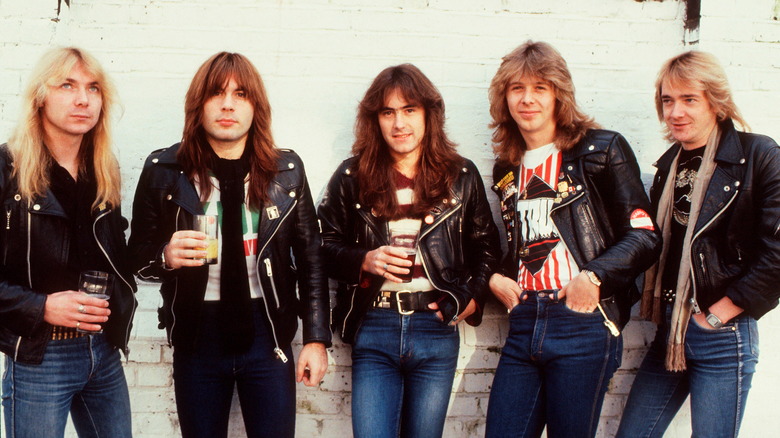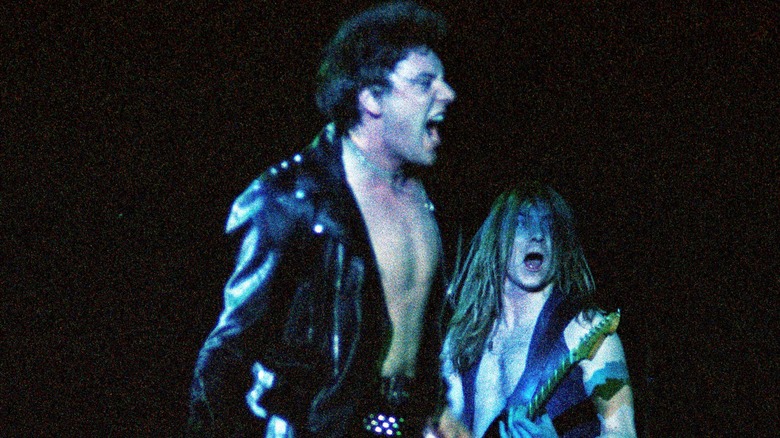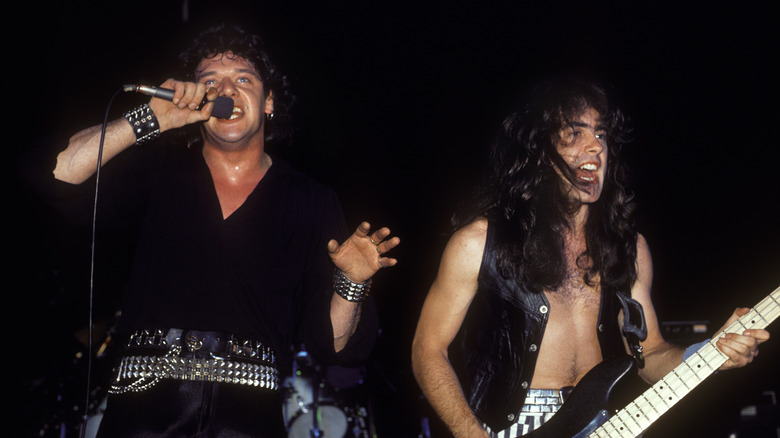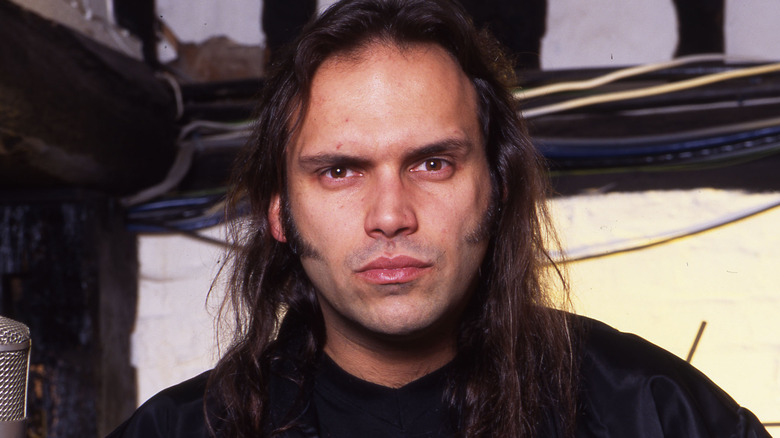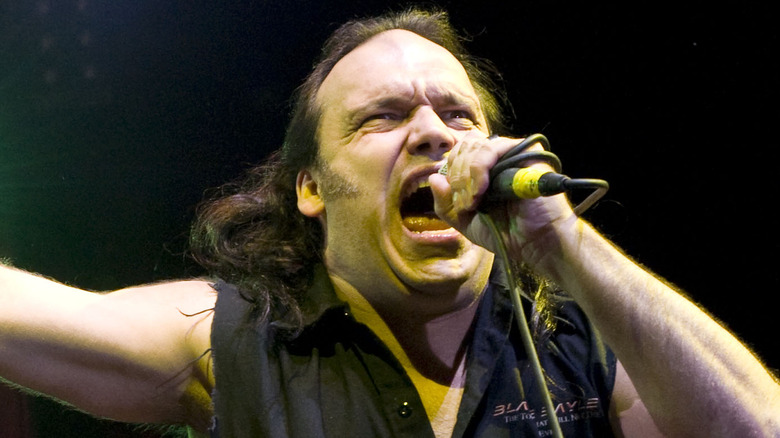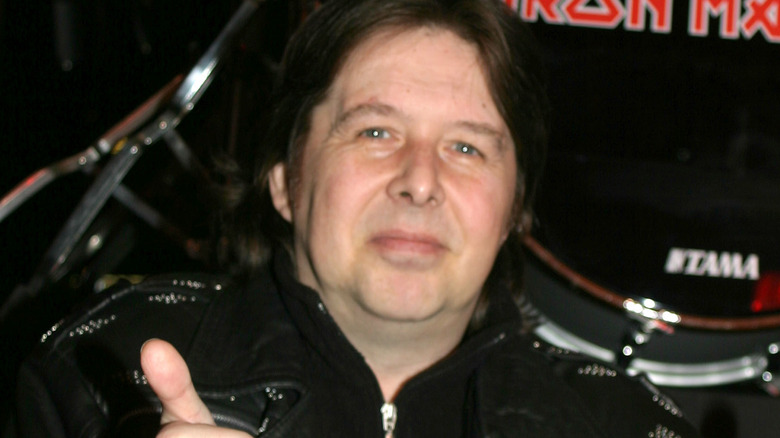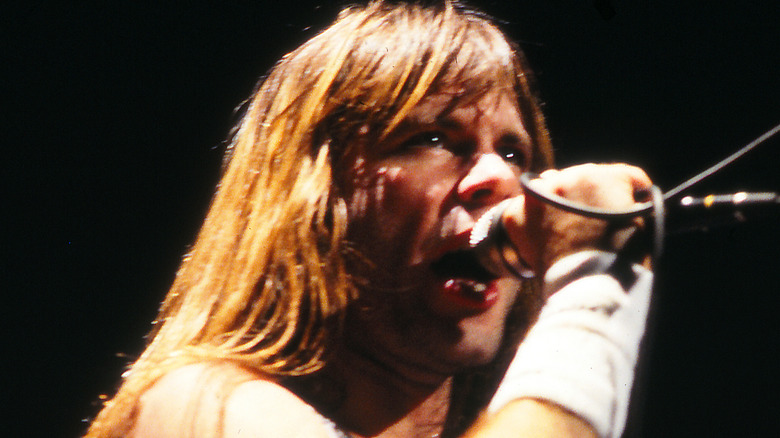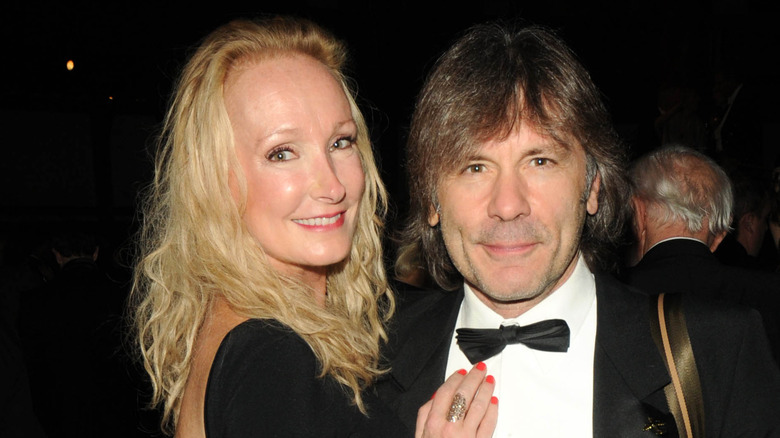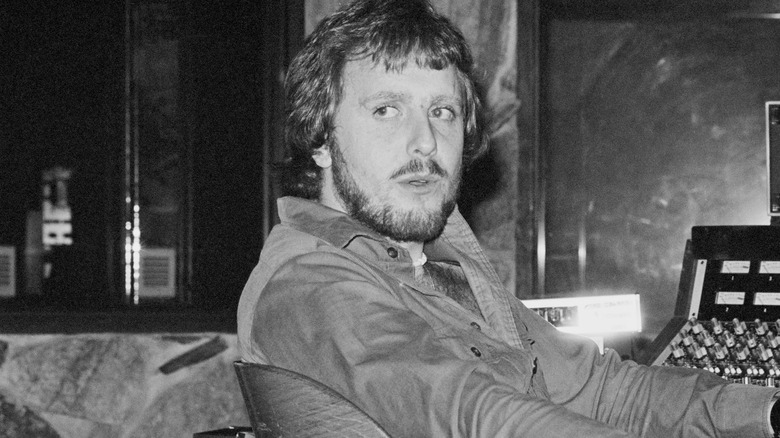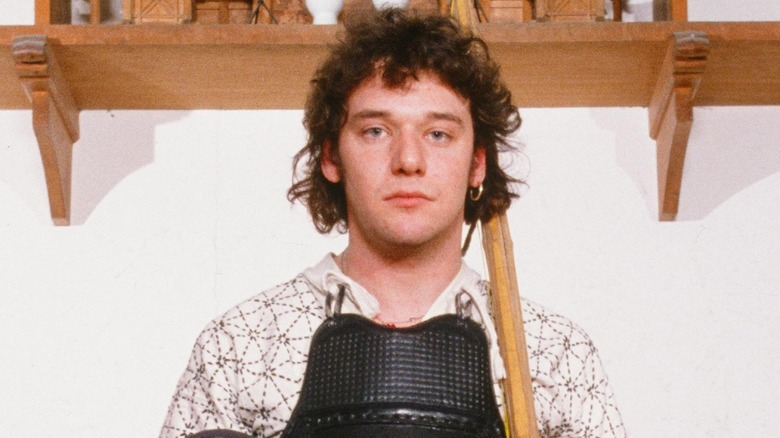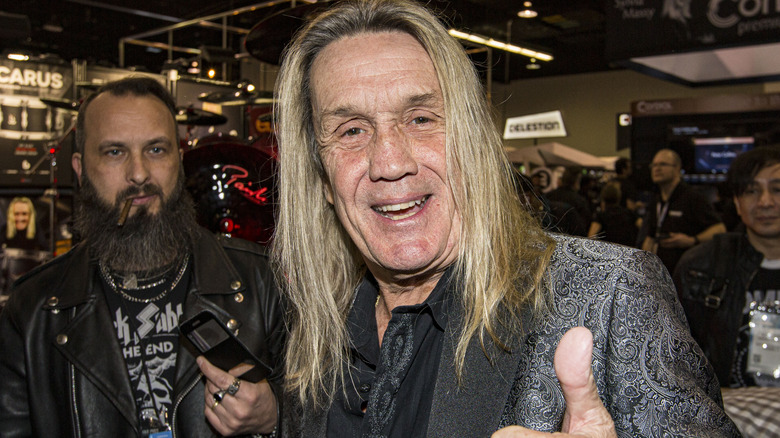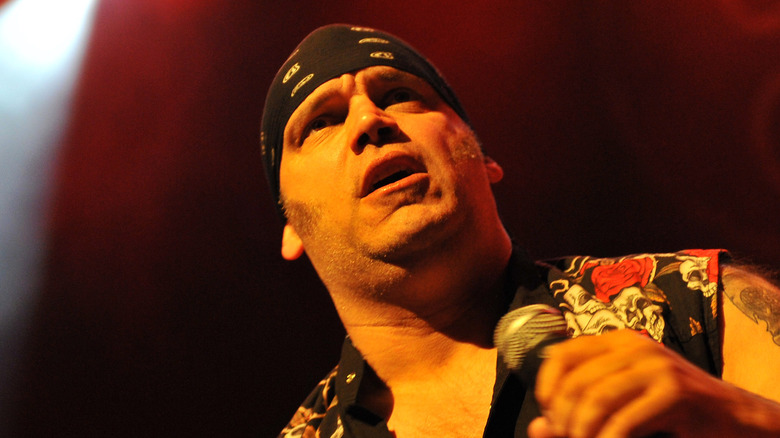The Tragedy Of Iron Maiden Explained
The music of Iron Maiden, a defining and foundational band in the British new wave of heavy metal of the 1980s, can be dark, twisted, and even frightening — reflecting the myriad personal, professional, and health issues faced by its members. Over its nearly five-decade history as one of the loudest, most aggressive, most head-bangingly ear-splitting bands of all time, many musicians have filed in and out of Iron Maiden. "Run to the Hills," "Can I Play With Madness," "The Number of the Beast," and "Bring Your Daughter... to the Slaughter," are just a few of the envelope-pushing metal classics the band ground out, all the while dealing for real with the kinds of things they made songs about.
Iron Maiden looms prominently in the bizarre history of heavy metal music, and has certainly experienced its fair share of horrors, mortality, torment, and pain. Its members have been maimed, struck by disease, dealt with death, and metaphorically ripped apart by the music industry. Here's a look at all the quite horrible and undeniably tragic chapters in the crazy real-life story of Iron Maiden.
The following article contains references to and descriptions of addiction.
Paul Di'Anno's drug addiction got him tossed out of Iron Maiden
Paul Di'Anno became the third lead singer of Iron Maiden in late 1978. He'd sing on two albums and last just about two years with the group, as his bandmates fired him in 1981 and replaced him with Bruce Dickinson. By the end of his tenure, his drug misuse had progressed to the point of addiction, and in such a prodigious, voluminous manner that his place in the band became untenable. "It wasn't just that I was snorting a bit of coke," he told Guitar Door. "I was just going for it non-stop, 24 hours a day, every day."
Aware that he had an issue at the time, Di'Anno wasn't sure that he could keep doing the job as lead singer of Iron Maiden, which in 1981 was growing quickly in popularity and booking dates months into the future. "I just couldn't see my way to the end of it. I knew I'd never last the whole tour. It was too much." His musicianship suffered under the weight of drug addiction, and right after the Killer World Tour ended in December 1981, Iron Maiden dismissed Di'Anno and installed the new singer they'd selected already: Bruce Dickinson, one of the most successful band member replacements ever.
Two people died at an Iron Maiden concert
In 1988, Iron Maiden was arguably at its peak of popularity. Its seventh album, "Seventh Son of a Seventh Son," topped the album chart in the U.K., and the band filled stadiums around Europe before headlining the ninth annual Monsters of Rock outdoor festival in Donington, England, in August of 1988. A record 107,000 people attended that event to see the biggest hard rock bands of the era, including Guns N' Roses, which performed just before Iron Maiden. The massive crowd pushed toward the stage, and several people lost their footing and fell underneath the lurching horde. Two young male fans died as Guns N' Roses witnessed the tragedy.
While Iron Maiden waited to go on, they remained ignorant of the events that had transpired, and still didn't know when they took the stage. "It was decided not to tell Iron Maiden about the tragedy," concert promoter Stuart Galbraith told Classic Rock. "I considered whether or not to tell the band, but decided against it as it would serve no purpose and make it immensely difficult for them to play with their hearts in it, which would let down an awful lot of fans," band manager Rod Smallwood added. He broke the news of the deaths after their set. "When I told them what happened to these poor kids they were devastated."
Blaze Bayley's tumultuous time in the band
When singer Bruce Dickinson left Iron Maiden in 1993, the band hired a replacement in Blaze Bayley, formerly of the metal band Wolfsbane. Bayley performed on two albums, and while his bandmates valued his contributions, large swaths of the fanbase rejected the new singer. "There were a lot of people who just resented me and actually hated me for being in Maiden, because they blamed me for Bruce leaving," he told "One on One with Mitch Lafon" (via Blabbermouth).
Bayley tries to take it in his stride, partly because he thinks public opinion was swayed by factors beyond his control. "CD sales were down for everybody worldwide, because bits of plastic weren't selling anymore. And it was a time when a lot of old-school Maiden fans did not want Blaze Bayley to be the lead singer." And the largely negative reviews for the Bayley-centric Iron Maiden albums, which took on a darker, more progressive rock tone, certainly didn't help the situation.
Iron Maiden agreed to let Dickinson back in the band in 1999, leading to Bayley's abrupt departure. "I left Iron Maiden, not by choice — I was fired. They said I wasn't good enough. And I said, 'Well, is Bruce coming back? And they said, 'Yes,'" Bayley recalled in a 2016 tour documentary (via Blabbermouth). "I was just gutted by that. I think it took me about four years, really, before I kind of accepted what had happened."
Blaze Bayley's wife's fatal health issues
Bruce Dickinson, one of a fair few musicians who left their bands, only to come crawling back, returned to Iron Maiden in 1999, and so the band fired previous singer Blaze Bayley. He'd launch a solo career, and would eventually hire his girlfriend, former dancer Debbie Hartland, to manage the band, and after a long professional and personal relationship, they married on Valentine's Day 2007. "I had a lot of problems with alcohol, severe depression, almost had a breakdown," Bayley told HeavyMetal.no (via Blabbermouth). "And then I met my wife."
In July 2008, one day after attending an Iron Maiden concert with her husband, Hartland collapsed at the home she shared with Bayley near Birmingham, England. Scans indicated that Hartland had endured a brain hemorrhage, and over the next few weeks, she underwent three neurological surgeries. However, she remained in a coma, showing few signs of improvement. In September 2008, another brain hemorrhage and an additional brain bleed occurred, leading doctors to tell Bayley that recovery was virtually impossible. Two days later, Hartland died. "That was my darkest time. When she passed, it was the end of the world," Bayley later told Metal Hammer." She died in my arms, in hospital. That's when part of me thought, 'I should stop now, just give up.'"
Clive Burr had multiple sclerosis
Clive Burr was the first Iron Maiden drummer to be heard on record, playing on the band's first three LPs, then was fired after the release of "The Number of the Beast" in 1982. Burr played drums for a succession of bands in the 1980s, but noticed a gradually worsening tingling in his hands by the decade's end. In 1994, he was forced to seek medical attention when the issue affected his drumming. "I kept dropping things. I couldn't grip properly. I could barely keep hold of my sticks," he told Classic Rock. After a battery of tests, exams, and doctor visits, Burr was diagnosed with primary progressive multiple sclerosis, an incurable disease that eliminates the protective covering on nerve fibers in the brain and spinal cord, eventually leading to a total lack of mobility.
Burr's health steadily declined, and in March 2013, he died while asleep at his home in England. He was 56 years old. "This is terribly sad news. Clive was a very old friend of all of us," Iron Maiden guitarist Steve Harris said on the band's website. "This is a sad day for everyone in the band and those around him."
Bruce Dickinson had cancer
Iron Maiden lead singer Bruce Dickinson learned that he had cancer of the throat in 2014. That's a frightening diagnosis not only because cancer can be a fatal illness, but because oral cancers can lead to the diminished ability to talk or sing. Dickinson, a lifelong non-smoker, believes a sexually transmitted disease he acquired through oral sex helped the cancer develop. "It's a virus. HPV — human papillomavirus," he told Sirius XM in 2015 (via Billboard).
Doctors discovered two cancerous tumors in the singer. Dickinson told Rolling Stone that one was a "three-and-a-half-centimeter, golf ball-sized tumor in the base of my tongue and a strawberry-sized one in my lymph node." The musician submitted to a rigorous and aggressive treatment regimen, enduring 33 sessions of radiation concurrently with nine weeks of chemotherapy. That plan was effective, and Dickinson's doctors pronounced him cancer-free, and as of 2024, he remains in remission.
As a cancer survivor, Dickinson stepped into an awareness-and-advocacy role. "I quite enjoy talking about it because you kind of demystify it a little bit for people. It's a scary thing," he said at a spoken-word show in 2022 (via Blabbermouth). "I have to say that the therapies that people are coming up with now are so on the edge and successful that you really do stand a very good chance. 'Cause half of us are gonna get cancer, and it's not a death sentence anymore, and you can deal with it."
Bruce Dickinson's wife died suddenly
Iron Maiden singer Bruce Dickinson started a romantic relationship with psychotherapist Paddy Bowden in 1988, and they married in 1990. After 30 years and raising three children together, the couple announced their separation in November 2019, having quietly split up in 2018. Dickinson moved to Paris to live closer to his new partner, fashion blogger Leana Dolci, while Bowden, remained in the family home in West London. That's where she was discovered dead, reportedly by a housekeeper, in May 2020.
An ambulance was called to the home, but authorities, some of whom entered the home wearing anti-contamination suits due to the ongoing COVID-19 pandemic, pronounced Bowden dead upon their arrival. "This is a terrible tragedy which appears to be a tragic accident. Our children Austin, Griffin, and Kia and I are devastated," Dickinson said in a statement (via Loudwire). "Out of respect for Paddy we won't be making any further comment at this hugely difficult and painful time for our family." No official cause of death was ever publicly revealed; Bowden was 58 years old.
Iron Maiden's producer suddenly died
Martin Birch wasn't a guitar-wielding metal musician, but he was extremely influential in developing and popularizing that genre through his work as a producer and engineer in the 1970s, 1980s, and beyond. He perfected the studio sound on albums by Deep Purple, Rainbow, Whitesnake, and Blue Oyster Cult, and he helped revive a pioneering heavy band after Ozzy Osbourne left Black Sabbath. However, he was most closely associated with Iron Maiden: Birch served as producer and engineer on every one of the heavy metal band's studio albums, from 1981's "Killer" to 1992's "Fear of the Dark."
Birch, an important figure in the untold truth of Whitesnake, died in August 2020, and his death was announced by that band's frontman, David Coverdale, on X, formerly known as Twitter. "He was just absolutely brilliant. He wasn't just a producer, he was a hands-on engineer too, so he knew how to get a great sound. He was also fantastic at motivating people; he just had a knack of getting the best out of you," Iron Maiden guitarist Steve Harris told Sirius XM's Eddie Trunk (via Variety). No cause of death was released to the media; Birch was 71 years old.
Paul Di'Anno's long-running health issues
After his termination from Iron Maiden, singer Paul Di'Anno embarked on a solo career and moved to South America. In the 2000s, his health began to deteriorate. Injured in multiple motorcycle accidents, Di'Anno was a candidate for knee replacement surgery. "I should have done this seven years ago. And now all the ligament is gone and all it basically is, is bone rubbing against bone," he told "Talking Metal" in 2015 (via Loudwire), adding that he'd also been diagnosed with the bone density disease osteoporosis. Di'Anno still performed, but required a wheelchair.
In May 2016, Di'Anno canceled a tour due to a medical problem for which he required hospitalization. After months of sustained treatment for various medical problems in 2022, he finally underwent knee surgery in Croatia. His medical bills were paid for with a crowdfunding drive and the assistance of his former Iron Maiden bandmates — his nearly fatal health problems had left Di'Anno virtually broke.
"I ran out of money. It's been very expensive. 'Cause when I first got sick, I had to get medevaced from Argentina, which cost me a lot of money, 'cause I had to in a private medical plane and all that stuff back," he told "MB Live" (via Blabbermouth). "When I arrived in England, I only had 45 minutes to live, with sepsis and that. So they pumped me full of antibiotics. I spent eight months in hospital."
Nicko McBrain had a devastating stroke
In 1982, Ronald Burr, father of Iron Maiden drummer Clive Burr, died from a heart attack at the age of 57. The musician took a leave of absence from the band to attend the funeral and to family matters, and when he returned, he got fired. Burr told Classic Rock that the rest of Iron Maiden said it was "time for a break," but really, they'd just decided that the supposedly temporary fill-in musician, Michael "Nicko" McBrain, was a better fit.
McBrain's fast, propulsive drumming powered Iron Maiden from 1982 until January 2023, when he suffered a minor stroke. "It left me paralyzed on my right side from my shoulder on down, of course I was very worried that my career was over," McBrain explained. After nearly three months of grueling occupational therapy, McBrain said that he felt his health was about 70% of what it once was, adding, "I unfortunately haven't been able to give you lot a hundred percent of my performance."
McBrain was able to play with Iron Maiden on some 2023 tour dates. "Honestly, what he did on the last tour was nothing short of amazing," Iron Maiden singer Bruce Dickinson told Brave Words in February 2024. "He started learning to drum again because he couldn't hold a stick. He couldn't hold a fork."
Blaze Bayley had a heart attack
In March 2023, during a break in a spring concert tour with his solo band, former Iron Maiden singer Blaze Bayley had a heart attack at his home in England. While his condition stabilized, the then-59-year-old singer's team had to cancel all upcoming shows while they awaited news — a triple bypass surgery was planned, but it turned into a quadruple bypass operation.
Proximity to medical facilities may have saved the life of the man who once recorded a solo album called "The Man Who Would Not Die." "Luckily, I live two minutes from an ambulance station and near four hospitals," Bayley told Metal Hammer. "The paramedics said to my fiancée, 'If it had been another 10 minutes, I don't think he would have been here.' I was very, very lucky." While he'd blame his eating habits and lack of self-care for the potentially fatal medical episode, Bayley remained aghast at the surgical procedure he had to go through. "They stop your breathing, they transfer all of that to a machine, then they cut you in half and they replumb you," he said. "Then they stick a couple of pipes in your chest to drain off all the goo and put you back together."
If you or anyone you know needs help with addiction issues, help is available. Visit the Substance Abuse and Mental Health Services Administration website or contact SAMHSA's National Helpline at 1-800-662-HELP (4357).
